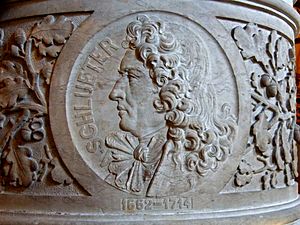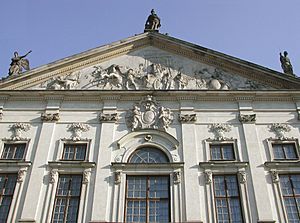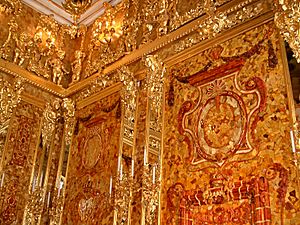Andreas Schlüter facts for kids
Andreas Schlüter (born 1659 – died around June 1714) was a very talented German sculptor and architect. He worked during the baroque period, which was a style of art and building with lots of fancy details. He created amazing works in different countries, including the Holy Roman Empire, the Polish-Lithuanian Commonwealth, and the Tsardom of Russia.
Biography of Andreas Schlüter
Andreas Schlüter was most likely born in Hamburg, Germany. Not much is known about his early life because there were a few people with the same name. Records show an Andreas Schlüter, son of a sculptor, was baptized in Hamburg in 1664. Other papers suggest he might have been born in 1659.
He probably traveled a lot when he was younger, learning from other artists. One of his first works, around 1675, might have been special stone carvings for dukes in a monastery in Pelplin.
Schlüter's first well-known project was decorating the outside of the Royal Chapel in Gdańsk in 1681. Later, he made statues for King John III Sobieski's Wilanów Palace in Warsaw. He also created sculptures for tombs in Żółkiew. In 1689, he moved to Warsaw. There, he made beautiful carvings and sculptures for the pediment (the triangular part above the entrance) of Krasiński Palace.
In 1694, Andreas Schlüter was invited to Berlin by Eberhard von Danckelmann. He became the court sculptor for Elector Frederick III. His sculptures for the Zeughaus (an armory or weapons house) are famous examples of baroque art. The sculptures on the outside showed battles. But inside, his statues of dying soldiers seemed to speak against war. This might have shown his peaceful beliefs. In 1696, he traveled through Italy. He studied the works of great masters like Michelangelo and Gian Lorenzo Bernini.
Schlüter also worked as an architect, designing many important buildings in Berlin. He was the "Hofbaumeister" (Court Architect). He lost this job when a tower he designed showed problems with its foundation. From 1702 to 1704, he was also the director of the Prussian Academy of Arts. After that, he focused more on sculpting again as the "Hofbildhauer" (Court Sculptor). His most important equestrian sculpture (a statue of a person on horseback) is of the "Great Elector," Frederick William of Brandenburg. This large statue was made in 1708. Today, it stands in front of Charlottenburg Palace.
Many of Schlüter's works, including the Berlin City Palace, were damaged during World War II. They were also affected by the later Communist government. The famous Amber Room, which he helped create between 1701 and 1709, likely faced a similar fate.
In 1713, Schlüter's fame led him to work for Tsar Peter the Great in Saint Petersburg, Russia. He died there from an illness in 1714. He designed parts of the Grand Palace and Monplaisir Palace in Peterhof. He also designed Kikin Hall, the city's oldest building, and carvings at the Summer Palace. His work greatly influenced the Petrine Baroque style in Russia.
Famous Works by Andreas Schlüter
- The outside decoration of the Royal Chapel in Gdańsk, 1681.
- Sculptures on the front of Wilanów Palace in Warsaw, after 1681.
- Sculptures on the pediment of Krasiński Palace in Warsaw, 1682–1693.
- A special tomb carving for Adam Zygmunt Konarski in Frombork, after 1683.
- An altar and crucifix in a church in Węgrów, 1688–1690.
- Tomb sculptures for the Sobieski family in Zhovkva, 1692–1693.
- An altar in Czerniaków church in Warsaw, 1690.
- A portrait of Bishop Jan Małachowski in Wawel Cathedral in Kraków, 1693.
- The equestrian statue of Elector Frederick William at Charlottenburg Palace in Berlin, 1689–1703. A copy is in the Berlin Bode-Museum.
- A reconstruction of the Amber Room in the Catherine Palace near Saint Petersburg, 1701.
- The pulpit in the Marienkirche in Berlin, 1703.
- Stone coffins for Friedrich I and Sophia Charlotte, king and queen of Prussia, in the Berlin Cathedral.
See Also
 In Spanish: Andreas Schlüter para niños
In Spanish: Andreas Schlüter para niños





